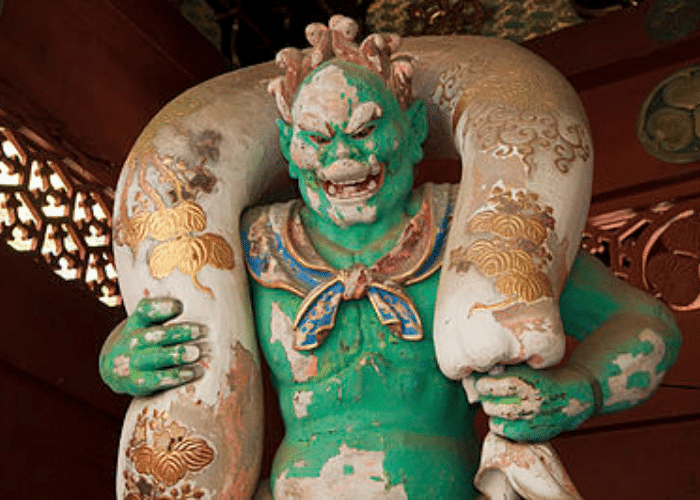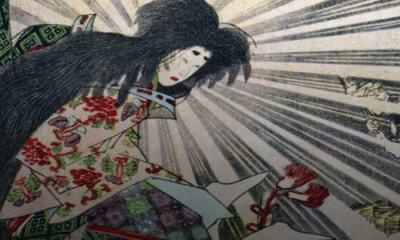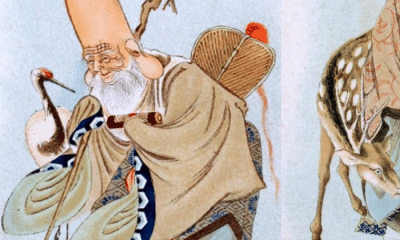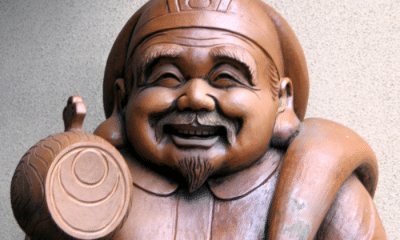
Japanese
Fujin: The Japanese God of Wind
Fujin: The Japanese God of Wind
The demonic Japanese god of the wind is both a threat to and a protector of the island nation. Remarkably, though, this well-known god traveled thousands of miles before becoming iconic in Japan.
Fujin is the Japanese god of the wind. Depicted as an oni, or malevolent spirit, he causes great destruction when paired with his brother, the storm god Raijin.
Fujin is not an entirely negative character, however. Despite his monstrous appearance and fearsome reputation, he can also be responsible for the calm winds that bring refreshment in summer and sent ships across the sea.
Even in his more malevolent aspect, the Japanese have found reasons to appreciate the wind god. When he and Raijin turned their powers against an enemy force, they became the saviors of the Japanese people.
Western viewers might be surprised by images of Fujin, however. This is not because they seem unusual, but because they are familiar to anyone who has seen Greek and Roman art.
Although separated by thousands of miles, the Japanese god of wind has a direct link to the Greek god who shares his iconography.
Fujin and the Storm Gods
As the god of wind, Fujin can be viewed as both a positive and a negative force.
The wind is often refreshing, particularly on a hot day. It brings the rain storms that fertilize crops and is vital to ships at sea.
Fujin could also be destructive, however. Blowing too hard, he could topple trees, damage buildings, and bring terrible storms.
Because of this possibility for destruction, Fujin is typically described as an oni, or demonic spirit.
His imagery reflects this. Usually shown with green skin and bulging eyes, his monstrous face is emphasized.
On his own, Fjuin is often welcomed. When paired with his brother Raijin, however, he is a terrifying force.
The two were children of Izanami, the primordial mother goddess. Unlike her more benevolent children, however, they were born after her death.
After Izanami died her husband, Izanagi, journeyed to the Underworld to try to bring her back. When he saw her as a rotting corpse, however, she sent a legion of demons to chase after him.
While Izanagi managed to escape, a few of his wife’s demons slipped out into the world behind him. Two of these were Fujin and Raijin.
Raijin is the more destructive and terrible of the two. He is the god of thunder, storms, and lightning.
Fujin is gentler, but is often pushed to destruction in his brother’s presence. When paired with Raijin, Fujin’s wind can be just as harmful as thunder or lightning.
Fujin is always on the move. He is never still and seems to be everywhere at once.
Images of Fujin in art show his ability to constantly move in any direction. Each of his hands has four fingers that point in different ways corresponding to the cardinal directions, symbolizing his ability to move wherever he wants.
While Fujin and Raijin are often feared, they are also credited with saving Japan from invasion.
When the Mongol emperor of China attempted to invade Japan in 1274, his army seemed unstoppable. A sudden storm, however, destroyed much of his fleet and pushed the rest back to China’s shores.
While the people of Japan celebrated this narrow escape, they knew the Emperor would not be swayed by a single rogue storm. They spent the next several years reinforcing their defenses in preparation for another attack.
The attack came in 1281 after the Japanese had killed many of the Chinese diplomats who had demanded their surrender. While they had attempted to fortify the coast, they were unprepared for the size of the invading force.
Sources claim that the fleet sent by the Mongols was the largest naval force in history. Tens of thousands of soldiers sailed toward Japan, including many conscripted Chinese and Korean peasants.
As the army landed, however, a typhoon hit. The storm lasted two days and destroyed virtually all of the massive fleet, leaving the stranded army to be drowned or killed by Japanese troops.
The Mongols decided that Japan was too risky to invade. They did not send another fleet.
Raijin and Fujin were credited with saving the country from destruction and occupation. While their typhoons could be deadly, they could also be Japan’s greeted defense against outside threats.
My Modern Interpretation
More interesting than the story of the Mongolian fleet to many scholars, however, is the way in which Fujin is depicted in art.
In addition to his green or black skin and contorted facial features, the god of wind has many other identifying attributes.
He carries a large bag that holds all of his wind. He holds it in both hands so it arcs above his head.
Fujin typically rides on a cloud. Its color changes depending on whether he is acting benevolently or demonically: white for a light wind and gray for a storm.
This imagery is familiar to many Western audiences even if they are not well-acquainted with Japanese art. With the exception of his skin color, Fujin is almost identical to the Greek wind god Boreas.
The cultures of Europe and East Asia are often thought to be completely separate from one another. They developed independently, according to the common view, and had virtually no significant exchange of ideas until relatively recent times.
The imagery of Fujin challenges this popular assumption, however. It is too similar to Greco-Roman iconography to have developed by coincidence.
In fact, historians can clearly trace the way in which the Greek wind god was imported to Japan. While it was not a direct route, it follows other known exchanges in the ancient world.
While the Greek culture was largely centered on the Mediterranean for much of its ancient history, they had a significant presence in the Near East. Based out of colonial cities in modern Turkey, Greek traders pushed further inland in their search for new markets.
Eventually, Greek armies followed suit. Alexander the Great would change the scope of Greek culture when he led his troops into what is now Afghanistan, Pakistan, and northwestern India.
While Alexander’s expansive empire would not last after his death, Greek interaction with the Indian subcontinent would.
Macedonian generals would remain in control of parts of the region for the next decade. When they withdrew, they left behind trade routes that continued the contact between the cultures.
A new tradition grew in the East in which the recently-introduced Greek gods were incorporated into local Buddhist lore. In Bactria, which is now present-day Afghanistan and north Pakistan, characters such as Heracles were commonly seen alongside Buddhist gods.
Boreas, the god of wind,was one of the gods introduced to Central and Southern Asia at this time.
Bactria controlled major trade routes to India not only from the Near East, but also from China. Chinese merchants from the East took Buddhist beliefs back to their homeland along with money and trade goods.
Chinese Buddhist took the imagery ofthe new Bactrian gods. The imagery of Boreas was incorporated into local wind gods.
From China, this image passed easily into Japanese Buddhism. While Fujin was given the markers of an oni with his dark skin and demonic face, he maintained the bag of wind, cloud seat, and recognizable pose of Boreas.
Because Japanese religions were frequently syncretic, meaning that they combined and shared ideas and legends, Fujin was not limited to Buddhism. In a short amount of time his new imagery was incorporated into Shinto as well.
Over the course of a few hundred years or less, the image of a Greek god traveled thousands of miles to an unrelated culture and was incorporated into popular Japanese belief as an oni of the wind.
In Summary
Fujin is the Japanese oni, or demonic spirit, of the wind.
Although he can be beneficial when he moves as a light breeze, he can also be a terrible god. When working with his brother Raihin, the storm god, he brings tsunamis that can destroy entire towns.
They can also destroy fleets. During two attempted Mongol invasions, Fujin and Raijin used their powers to summon storms that drove off the invading ships and saved the Japanese from almost certain destruction.
While images of Fujin show him with a distorted face and discolored skin like many oni, other aspects of his iconography are unique in Japan.
They are not, however, unique elsewhere. They originated with the Greek wind god Boreas.
Although separated by thousands of miles and belonging to an unrelated culture, the Greek image of the wind god was taken almost unchanged from Alexander the Great’s Indian and Bactrian colonies into Buddhist iconography.
Moving through China, the image was introduced to Japan and soon adopted by both Buddhist and Shinto artists. Although his characterization and mythology is completely different, the image of Fujin is recognizable as a variation of a Greek god.







